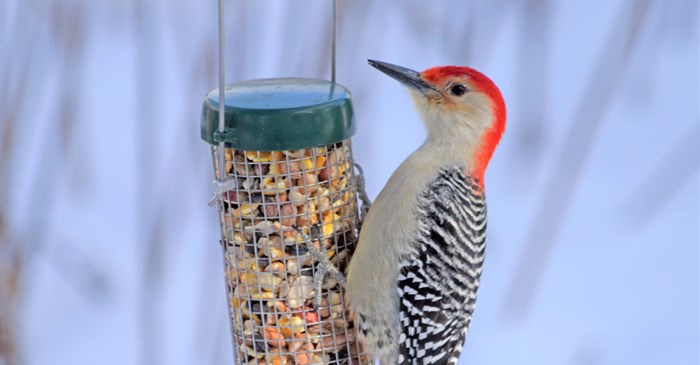The colder and snowier it gets, the more precious birds visiting feeders become. They utilize feeders as other food sources more commonly found in warmer months of the years become scarce. Feel good about helping our feathered friends during the winter months by providing safe and healthy feeding spots.
What Feeders Should I Use in Winter?
Many of the feeders you’d use in warmer times work perfectly well in winter, too. Here are a few tips to consider.
- Hopper Feeders are great options during the winter, as they include sides and a top that can protect the seed from any weather conditions. You can use any type of seed in these, as any food products that don’t have protective shells will still be protected by the feeder.
- Platform or Tray Feeders with Covers are also great options during the winter months. Their cover allows the seed to be protected from winter elements while providing easy access to food for birds.
- Platform or Tray Feeders without Covers have less protection than other types of feeders but are still great options for birds who use them. Be sure when using feeders without covers to use seed that is in its shell - this will keep any exposed seed from spoiling.
- Tube Feeders are a great option for winter months as well. They provide protection of seed while giving the birds access to the food at the bottom of the feeder and at the holes that are commonly placed throughout the sides of the feeder.
- Nyjer Tube Feeders are similar to regular tube feeders but are made with smaller holes so that tiny Nyjer seeds don’t easily fall from the feeder.
- Nyjer Sock Feeders don’t provide a ton of seed protection - but since Nyjer seeds are in their own shell - they have a natural layer of protection. Be sure to keep an eye on the seed and make sure it is healthy for your small feathered friends.
- Wire Mesh Feeders normally have some form of a cap to them, providing some level of protection to the seed. Keep an eye on the feeder to be sure that the lower seed isn’t affected by winter conditions.
- Window Feeders are a great way to get up close and personal with birds, and can either come with or without covers. In either case, make sure to watch for any seed deterioration within the feeder so that birds continue to stop in to say hello!
How to Maintain Feeders Over the Winter
Regularly cleaning bird feeders is generally a good idea but can be extra important in winter. The humidity from melting ice and snow may encourage mold to grow, so it is important to use appropriate feeders for the weather and clean them regularly. When cleaning your feeders over the winter, you should clean them every two weeks with a solution of 9 parts water to one part bleach. Anytime you clean your feeders, let them dry completely before refilling them. Also, be sure to wash your hands anytime after you handle a bird feeder.
Finally, consider moving your feeders to a sheltered area. This has two major benefits. First, it makes it easier for birds to find food even in inclement weather. Second, it’s likely to reduce the amount of snow and ice you have to clear away after storms.
High-quality Food for Maximum Energy
High-fat foods help birds stay healthy and strong over winter. Lyric carries several great winter options including Fruit & Nut High Energy Mix, Cardinal Mix, Woodpecker Mix, and Delite No Waste Mix. Different foods attract different birds, so try a variety to see what shows up at your feeders.
